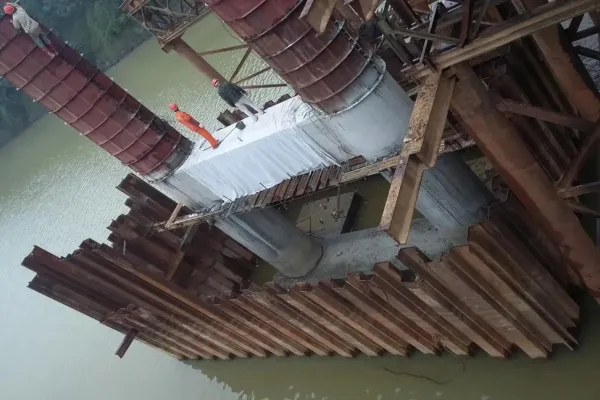Steel sheet piles have been widely used in construction projects since their introduction in early 20th-century Europe. As a recyclable and eco-friendly structural material, steel sheet piles offer high strength, lightweight properties, excellent water resistance, durability, and high construction efficiency. They are extensively applied in both permanent and temporary projects, including ports, docks, riverbank protection, retaining walls, and underground structures.
Despite their widespread use in global engineering projects, the adoption of steel sheet piles in China remains at an early stage. The annual consumption of steel sheet piles in China is only about 30,000 tons, which is disproportionately low compared to the country’s massive steel consumption—accounting for nearly one-third of the world's total. As China continues to urbanize, the demand for advanced geostructural solutions, including anchored geostructures, is growing. This article provides an in-depth analysis of steel sheet piles, including their types, design principles, installation methods, and maintenance considerations.
Types of Steel Sheet Piles
Steel sheet piles are primarily manufactured in Japan, South Korea, and Luxembourg. The main types include:
U-Type Steel Sheet Piles – Characterized by their high bending resistance and excellent interlocking performance.
Z-Type Steel Sheet Piles – Known for their superior load-bearing capacity and efficiency in retaining structures.
Combined Sheet Piles – A system that integrates different types of sheet piles to enhance structural performance.
Hat-Type Steel Sheet Piles – A newer innovation, particularly popular in Japan, featuring a 900mm width for increased efficiency and stability.
Design Considerations for Steel Sheet Piles
Proper design is crucial to ensuring the stability and safety of steel sheet pile structures. Key factors to consider include:
1. Soil Layer Analysis
Steel sheet pile design must account for varying soil conditions, which influence installation feasibility and structural stability.
Soil Type: Soils are generally classified as hard, medium-hard, or soft. Hard soils require thinner steel sheet piles, whereas soft soils demand thicker piles to withstand external forces.
Groundwater Level: High groundwater levels significantly affect pile performance. In such cases, embedding piles into clay layers can enhance stability.
Penetration Resistance: The presence of stones and hard materials in the soil impacts driving efficiency. Advanced pile-driving techniques, such as vibratory hammers or hydraulic presses, may be required.
2. Structural Design Factors
Several engineering factors must be addressed when designing steel sheet pile walls:
Overlap Stress: This refers to shear forces between adjacent sheet piles. Modern design approaches combine mathematical models with experimental data to ensure structural integrity.
Longitudinal Gaps: Controlled spacing between sheet piles enhances bending stiffness while minimizing shear stress.
Web Protection: Since the web is the thinnest part of the pile, protective measures such as alloy wire reinforcement or anti-corrosion coatings are necessary.

Installation and Maintenance of Steel Sheet Piles
Beyond design, proper installation and maintenance are essential to ensuring long-term durability and performance.
1. Installation Best Practices
Use of Appropriate Equipment: Proper machinery, such as vibratory hammers, hydraulic presses, or impact drivers, should be selected based on soil conditions.
Alignment Precision: Ensuring correct alignment during installation reduces structural stress and enhances stability.
Safety Measures: Strict adherence to safety protocols prevents accidents and ensures compliance with construction standards.
2. Maintenance and Corrosion Protection
Steel sheet piles require periodic inspection and maintenance:
Anti-Corrosion Treatments: Regular application of protective coatings, cathodic protection, or epoxy treatments can extend pile lifespan.
Structural Inspections: Routine checks help identify damage or deformations early, allowing for timely repairs or replacements.
Cleaning and Surface Treatment: Keeping sheet piles clean prevents rust accumulation and ensures continued performance.
Conclusion
Steel sheet piles are a crucial material for modern geotechnical and marine construction. Their high strength, ease of installation, and recyclability make them an environmentally friendly choice for a wide range of applications. However, proper design, installation, and maintenance are key to maximizing their effectiveness and longevity. As China continues to develop its infrastructure, increased adoption of steel sheet piles will play a vital role in sustainable and efficient construction.
By optimizing engineering techniques and leveraging advanced materials, the construction industry can further harness the potential of steel sheet piles, ensuring durable and cost-effective solutions for complex geotechnical challenges.BAOWI STEEL provides various steel sheet piles and various steel pipes, including
seamless pipes, welded pipes and various
pipe fittings. If you have any needs, please feel free to contact us.






 English
English Español
Español بالعربية
بالعربية











 Phone :
Phone :  Whatsapp :
Whatsapp :  Email :
Email : 


